 |
 |
 |
 Travel & Outdoors | November 2006 Travel & Outdoors | November 2006  
Sailing for the 'Real Thing'
 FONATUR - PRNewswire FONATUR - PRNewswire

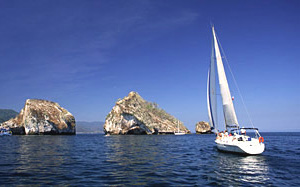
| 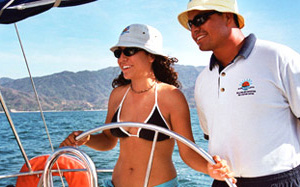
| 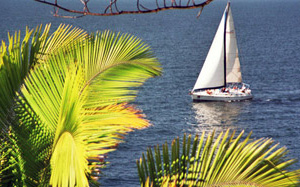
| 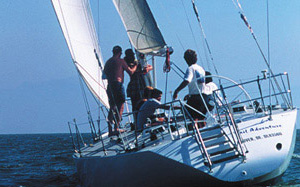
| 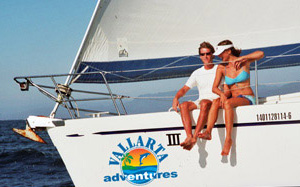
| | Vallarta Adventures offers exclusive sailing tours on Puerto Vallarta's Banderas Bay. Their luxury sailing yachts are reserved for small groups of 14-16 guests, and come staffed with a personal crew that scrupulously attends to the smallest details to ensure that your sailing experience is the adventure of a lifetime! Click HERE for more info. |
The grey whale may not be the only inhabitant of the sea heading to the warmer waters of the Mar de Cortes within the next month.

With a wealth of unique wildlife and almost 3,500 miles of isolated coastline from south of San Diego to Puerto Vallarta, many are finding that Mexico's Northwestern region is the perfect place to be one with nature ... and an anchor.

"It is serenely peaceful and significantly comfortable this time of year, especially if you like to see lots of fins, plumes of spray, giant manta sting rays, toothless whale sharks and marlin chasing schools of bait fish flashing through the water," commented Don Beaumont, an executive yachtsman and marina expert, who has navigated both bodies of water on the Pacific and Mar de Cortes side during a good portion of his adult life.

The environmental wealth of the Mar de Cortes, christened by legendary marine biologist Jacques Cousteau as "The Aquarium of the World," is home to a large number of marine species not easily found elsewhere, due to its long isolation and individual evolutionary history. It is home to 695 vascular plant species, more than any other marine and insular property included on the World Heritage List.

Equally exceptional is the number of fish species: 891, ninety of them endemic. The region also contains 39 percent of the world's total number of species of marine mammals and a third of the world's marine cetacean species. Scientists also have estimated that nearly 30 percent of the reptiles, mammals and vascular plants that live on the coast or in some of the 922 islands and islets scattered along the region are unique species.

Taking into account the region's natural and cultural richness, Mexico's National Trust Fund for Tourism Development (FONATUR), alongside with federal, state and municipal organizations, have taken a conservationist's approach to socio-economic improvements using the tourism formula.

"Our strategy is to preserve one of the most strikingly beautiful regions of the world, while at the same time create jobs, restore the existing infrastructure and lift the overall quality of life for the local people who live in these isolated coastal villages that pepper the hair-pin coast of the Mar de Cortes," said John McCarthy, CEO of FONATUR.

Branded by officials as the "Mar de Cortes" project, yet still casually referred to by others as the Nautical Ladder, existing villages are being integrated by an interconnected network of 28 first-rate marinas, which serve as ports of call linked to villages and an "eco-circuit" of land routes, which stem from down and around the mainland and the Baja peninsula. Each are located a comfortable sailing distance of approximately 120 nautical miles apart from each other. Some were renovated from existing structures, while others are new, yet all equipped with boat fuel, nautical supplies, medical services, laundry facilities, showers ... and even wireless internet. In some villages, basic services such as electricity, drinking water facilities and street lights have also been installed.

Three of the 28 ports of call are open in Loreto, La Paz and Puerto Penasco (Rocky Point), with four more planned to open within the next few weeks in Santa Rosalia, San Felipe, San Blas, and Mazatlan. Eleven more will be built in 2007 and another eight more during the next four years, according to FONATUR officials. Some of the closest are located 200 miles from Phoenix, 550 miles from Los Angeles and 445 miles from San Diego.

In addition, for boaters coming from the West Coast of the United States and wanting to get inside the Mar de Cortes, FONATUR will open an 80-mile "land bridge" allowing boats to be towed in less than four hours between Santa Rosaliita and Bahia de los Angeles, thus avoiding a six-day lengthy trip around the peninsula. The short cut leads to the country's largest islands of Spiritu Santo, Tiburon and Angel de la Guarda or north to Sonora and Rocky Point.

The work done also ensures a better experience for U. S. travelers and yachters.

"I think what this all adds up to is security. You will feel safe. There is always that next step where you will find whatever is needed in case you run into trouble, which happens from time to time," remarked Beaumont, who has sailed through lesser conditions in the past.

"Anyone who has sailed around the peninsula in the Baja area, couldn't go further than La Paz because there was no fuel to be found. Now, I can sail up from La Paz to Loreto and fuel my boat at a new first-class PEMEX station at the marina. No more having to take gas cans 20 minutes into town and back to fuel my boat," Beaumont added.

The idea mirrors a similar design from Spanish missionaries 300 years ago when they created a network of missions near these villages.

"They knew that they had to have a certain distance between one mission to the next to offer a haven for travelers ... and that applies to our ports-of- call network underway. Sailboats and small yachts can stay a few days then sail to the next village," further explained McCarthy.

Once anchored, a series of carefully traced-out land routes aid nautical travelers to organize their activities. Each marina is a gateway to experience 18th and 19th century architecture, archeology, flora and fauna. Highlights include the church designed by Gustavo Eiffel, the engineer of the Eiffel Tower. Cave paintings, like those at Sierra of San Francisco, which were declared Cultural Heritage of Humanity sites by UNESCO in 1993. Spanish missions, such as those of Comondu and San Ignacio and old towns like Mezcaltitlan, El Fuerte and Santa Rosalia and a great variety of folk art from ethnic groups such as the Huicholes, Mayos, Yaquis, Seris and Pimas. Local gastronomy includes roasted clams (almejas chocolatas), potatoes stuffed with lobster, seafood tacos, marlin, tuna and escargot.

"The Mar de Cortes and its islands have been called a natural laboratory for the investigation of speciation," declared the United Nations' Educational, Scientific and Cultural Organization (UNESCO), when it declared the region a World Heritage site. "Almost all major oceanographic processes occurring in the planet's oceans are present, giving it extraordinary importance for study."

"The site is one of striking natural beauty in a dramatic setting formed by rugged islands with high cliffs and sandy beaches, which contrast with the brilliant reflection from the desert and the surrounding turquoise waters," the organization added.

In the five states that make up this region, there are 23 protected nature areas. They include the Upper Gulf of California, the Colorado River Delta, the Gulf Islands, San Pedro Martir Mountains, El Vizcaino, El Pinacate, the Great Desert of Altar and the Valley of the Cirios, ideal places for rest and relaxation, plant and animal study, hiking, mountaineering, rappelling, flight in various types of aircraft and, in general, adventure and eco-tourism.

Source: FONATUR | 
 | |
 |



